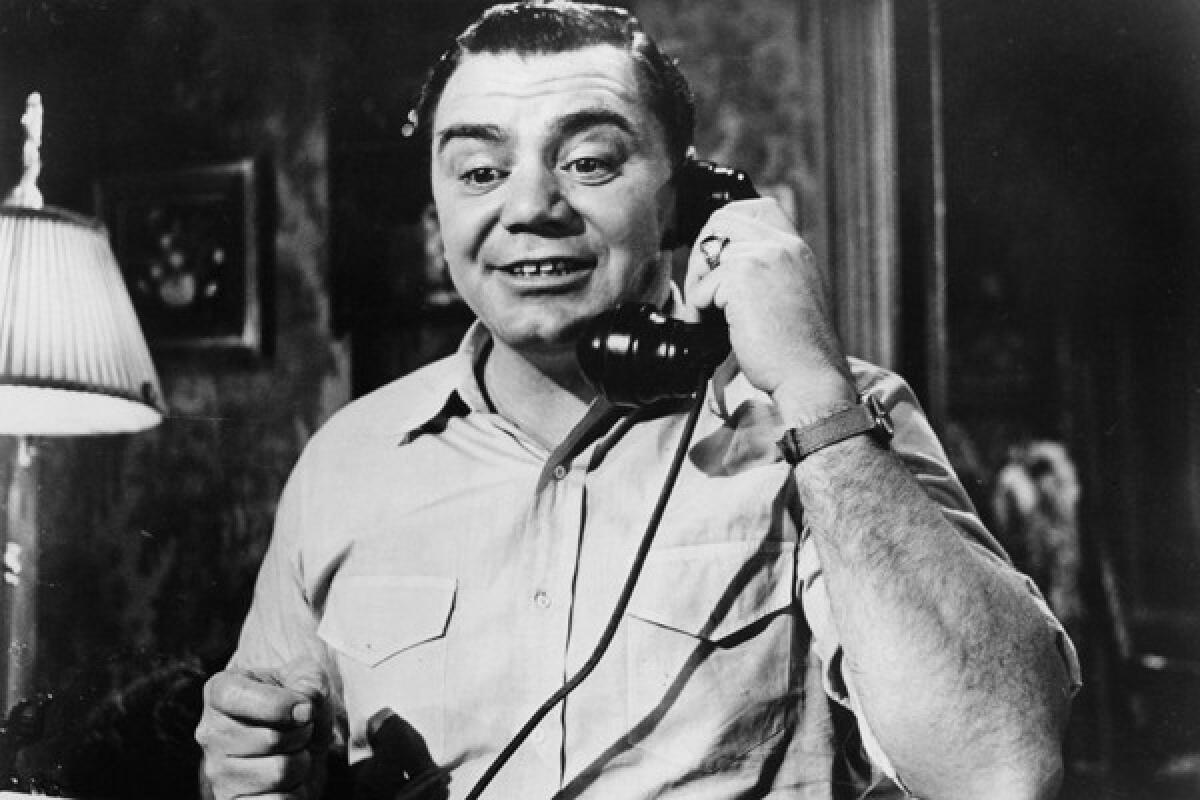Oscars: 1955 best picture ‘Marty’ conquered love, TV and film

- Share via
“Ma, sooner or later, there comes a point in a man’s life where he’s gotta face some facts. And one fact I gotta face is that, whatever it is that women like, I ain’t got it.” — Marty Piletti (Ernest Borgnine) in the 1955 Oscar winner “Marty”
On May 24, 1953, NBC’s “Goodyear Television Playhouse” aired Paddy Chayefsky’s transcendent drama “Marty,” starring Rod Steiger as a lonely Bronx butcher who finds love with a shy, plain woman (Nancy Marchand). Running just 51 minutes, the live telecast directed by Delbert Mann became one of the triumphs of the Golden Age of television in the 1950s.
The 1955 film version did even better, even though it was intended to be a failure. Not only did “Marty” become the second American film to win Cannes Film Festival’s key Palme d’Or, the low-budget, black-and-white movie also won four Academy Awards: best picture, actor for Borgnine, director for Mann (the first to win for a feature film directorial debut) and screenplay for Chayefsky. “Marty” is the only film based on a television production to win the top Oscar.
PHOTOS: Behind-the-scenes Classic Hollywood
So how did this little film get produced, let alone beat out such high-profile contenders as “Love Is a Many-Splendored Thing,” “Picnic” and “The Rose Tattoo” for the best picture honors?
Harold Hecht, who had been Burt Lancaster’s agent and then became his producing partner, had loved the TV drama and approached Chayefsky, whom he had known since the young writer had come to Hollywood after World War II. Chayefsky, though, had many demands before he would allow “Marty” to be made into a feature film, including consultation on casting and rewrites and insisting that Mann direct again. Hecht agreed to it all.
But Steiger turned down the offer to reprise his role. In 1991, he told The Times he regretted not doing the film, but he hadn’t wanted to be tied down to a contract.
BUZZMETER: Pundits’ Oscars 2014 picks
“I got a call from Hecht-Lancaster about doing the film version,” he recalled. “They said to me, ‘We want to sign you to a seven-year contract.’ I said, ‘I don’t think I want to sign for seven years with anybody, but the thing that will decide that is who chooses my parts.’ They said, ‘We will.’ I said, ‘No, I have a right to sleep with whom I please. You must not take my choices away from me. I have the right to my own mistakes.’”
Enter Borgnine, who was best known at the time for his memorable performance in 1953’s “From Here to Eternity” as vicious Army Sgt. Fatso Judson, who beat Angelo Maggio (Frank Sinatra) to death.
Borgnine told The Times in 1996 that Robert Aldrich, who had just directed him in 1954’s “Vera Cruz,” was asked at a party if he knew anybody who could play Marty. Aldrich recommended Borgnine after watching him on the set of the western.
TIMELINE: The Academy Awards through the years
“When I go away on location, not only to keep my own spirits up, but everybody else’s, I become a clown,” said Borgnine, who died in 2012. “I love to keep other people happy because when I go behind my door at night, I want to remember that happiness instead of being glum and gloomy at the end of the day. Bob Aldrich evidently saw the difference between the two — I could play a bad guy and I could play that crazy fellow — and he put two and two together.”
Borgnine recalled his meeting with Hecht. “We want you for a picture called ‘Marty.’ I looked at him and said, ‘Do you have faith in me, sir?’ And he said, ‘Of course I do. Otherwise I wouldn’t ask you.’ I said, ‘That’s all I wanted to know. I will give you 110%.’”
Budgeted at less than $350,000, “Marty” began production in the Bronx in early fall 1954. Esther Minciotti, who played his nagging mother, and Joe Mantell, who played his friend, reprised their roles from the TV program. Gene Kelly’s then-wife, Betsy Blair, took over the role of Clara from Marchand.
VIDEO: Highlights from the Envelope Screening Series
“We made the picture in 18 shooting days, and I got nothing for it except $5,000 and a promise to put me under contract if everything was all right,” recalled Borgnine. “As it turned out, everything came out like gangbusters.”
But in a 2008 Times interview, Borgnine said that there had been a tax issue with the production of “Marty.”
“Hecht-Lancaster wanted to lose money because they were making so much money from their other pictures,” said Borgnine. “They wanted to shoot half of it and then put it on the shelf and take a tax loss. Their tax man said, ‘You can’t do that. You have to finish it and show it one time and then take your tax loss.’ Then, bam! Everything happened. They never expected it to be a hit.”
Apparently, United Artists wanted to release “Marty” as a second feature on double bills. But Chayefsky insisted that the studio give it an art-house theater release in New York. UA did, and the film received rave reviews.
And just as Marty found love, so did the film. Not only did “Marty” win Oscar gold, it became a box-office hit, earning $3 million domestically.
More to Read
Only good movies
Get the Indie Focus newsletter, Mark Olsen's weekly guide to the world of cinema.
You may occasionally receive promotional content from the Los Angeles Times.










